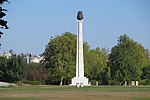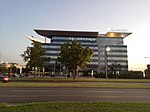Hyatt Regency Belgrade
Hotel buildings completed in 1990Hotels established in 1990Hotels in BelgradeHyatt Hotels and ResortsNew Belgrade ... and 1 more
Yugoslav Serbian architecture

Hyatt Regency Belgrade is a modern 5-star hotel located in New Belgrade, Belgrade, Serbia. It is part of international hotel group Hyatt Regency. Located across the street from Ušće Tower and Ušće Shopping Center, it is close to both the city centre and Sava Center, and fifteen minutes from Belgrade Nikola Tesla Airport.
Excerpt from the Wikipedia article Hyatt Regency Belgrade (License: CC BY-SA 3.0, Authors, Images).Hyatt Regency Belgrade
Milentija Popovica, Belgrade New Belgrade (New Belgrade Urban Municipality)
Geographical coordinates (GPS) Address External links Nearby Places Show on map
Geographical coordinates (GPS)
| Latitude | Longitude |
|---|---|
| N 44.813055555556 ° | E 20.434444444444 ° |
Address
Hyatt Regency Belgrade
Milentija Popovica 5
11000 Belgrade, New Belgrade (New Belgrade Urban Municipality)
Central Serbia, Serbia
Open on Google Maps








